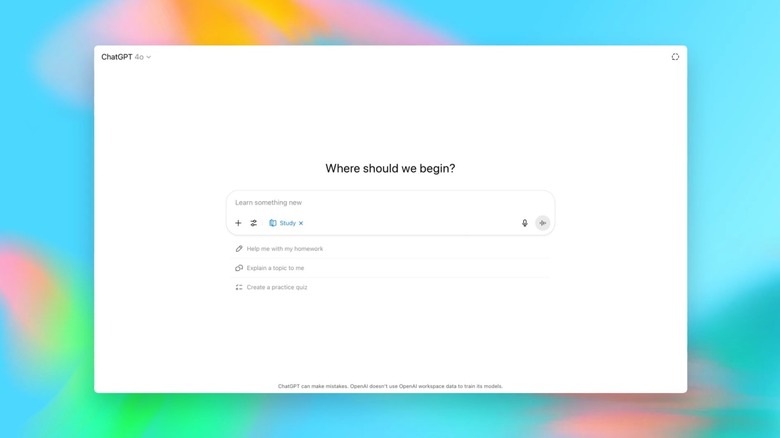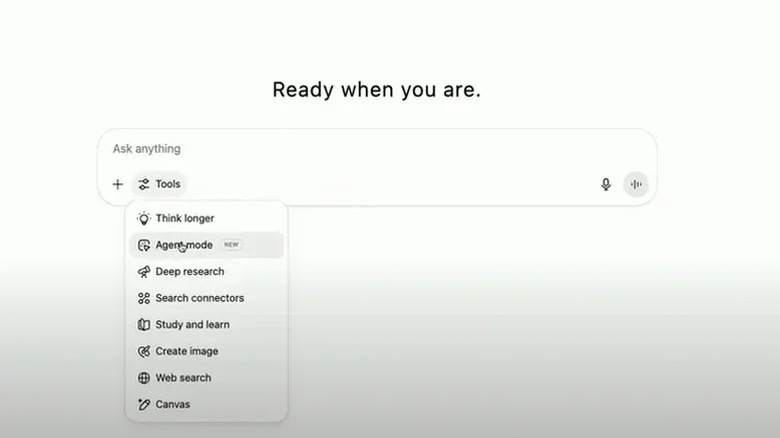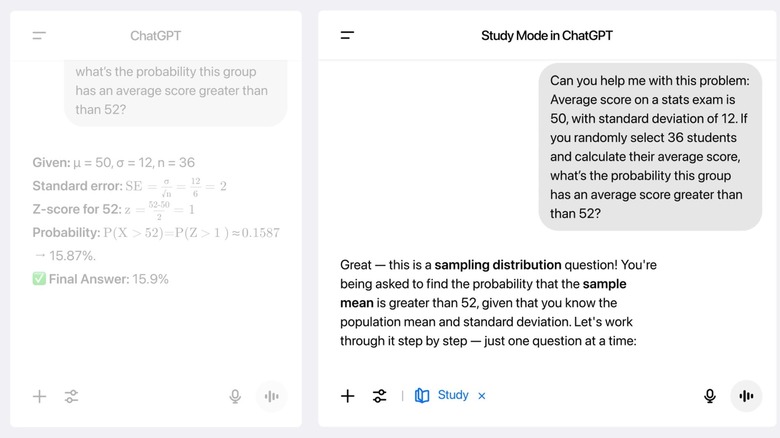ChatGPT's Study Mode Only Works If You Stop Cheating
Earlier this month, a number of leaks indicated that OpenAI was about to unveil a new "Study Together" mode for ChatGPT that would act as a tutor, similar to Claude's Learning Mode that dropped in April. Then, OpenAI unveiled ChatGPT Agent, its new AI agent that can work in a virtual computer on your behalf, leaking the new "Study and learn" mode in the process. The image below is a screenshot from OpenAI's ChatGPT Agent livestream that listed "Study and learn" right under "Agent mode" and "Deep research."
These were all signs that the launch of the new ChatGPT tutor mode was inevitable, and might arrive even before OpenAI released its most anticipated ChatGPT products of the summer: the open-source ChatGPT model and the GPT-5 upgrade. OpenAI finally announced the new mode on Tuesday, and it's widely available to ChatGPT Free, Plus, Pro, and Team users. OpenAI calls it "Study Mode," but you'll have to look for the "Study and learn" option in the tools section of the prompt composer, as seen in the following screenshot.
It's also important to understand that Study Mode will not stop students from cheating just because they have an AI tutor that doesn't spill out the answers as soon as you give it homework to solve. Students will have to choose not to cheat on their own.
Why do we need ChatGPT's Study Mode?
When ChatGPT began finding an audience, schools were rightly terrified. Students would use ChatGPT to do their homework and to cheat during exams, so the AI chatbot was banned almost immediately after becoming widely available. Now, AI use for cheating remains a valid concern, but the AI can also be an invaluable resource for learning if used correctly.
That's where Claude's Learning Mode and ChatGPT's Study Mode come in handy. The AI will help you do your homework by providing instructions that guide you to the answer without simply doing the work for you. ChatGPT's Study Mode can also help you understand more difficult concepts and create quizzes to prepare you for your next exam.
As ChatGPT becomes a go-to tool for students, we're committed to ensuring it fosters deeper understanding and learning.
Introducing study mode in ChatGPT — a learning experience that helps you work through problems step-by-step instead of just getting an answer. pic.twitter.com/B8VbRYJH6r
— OpenAI (@OpenAI) July 29, 2025
These AI modes should encourage students to think on their own rather than take the easier route and ask for the answer. Recent research has shown that ChatGPT use can erode critical thinking. Teaching students to use AI throughout the learning process might better prepare them for a world where AI assistance will be available everywhere they look.
But ChatGPT's Study Mode is optional. You have to pick it from the ChatGPT Tools menu and decide not to cheat. OpenAI explained to TechCrunch that ChatGPT doesn't offer parental controls to lock students in Study Mode. The following screenshot shows how easy it would be to cheat and just ask for the answer rather than using Study Mode to learn how to solve a math problem.
ChatGPT Study Mode features
OpenAI explained in a blog post that "Study Mode is powered by custom system instructions we've written in collaboration with teachers, scientists, and pedagogy experts to reflect a core set of behaviors that support deeper learning including: encouraging active participation, managing cognitive load, proactively developing metacognition and self reflection, fostering curiosity, and providing actionable and supportive feedback."
OpenAI listed the following "key features" for Study Mode that users can experience today:
- Interactive prompts: Combines Socratic questioning, hints, and self-reflection prompts to guide understanding and promote active learning, instead of providing answers outright.
- Scaffolded responses: Information is organized into easy-to-follow sections that highlight the key connections between topics, keeping information engaging with just the right amount of context and reducing overwhelm for complex topics.
- Personalized support: Lessons are tailored to the right level for the user, based on questions that assess skill level and memory from previous chats.
- Knowledge checks: Quizzes and open-ended questions, along with personalized feedback to track progress, support knowledge retention and the ability to apply that knowledge in new contexts.
- Flexibility: Easily toggle study mode on and off during a conversation, giving you the flexibility to adapt to your learning goals in each conversation.
Always check your work
ChatGPT Study Mode might be powered by a set of complex custom instructions rather than being a brand-new AI model, but it's still a handy tool that students everywhere can use to get help with homework and exams. Interestingly, ChatGPT Edu users, which might need Study Mode the most, do not have access to it yet. On the other hand, all ChatGPT users on premium plans will see Study Mode in the prompt composer, including those based in the EU. We can confirm that the mode is available in Europe at the time of writing.
We'll also remind you one important thing about using any AI model, whether it's ChatGPT Study Mode or something else. AI can make mistakes, so you'll want to verify that the information it provides is consistent with your syllabus frequently. AI chatbots can be a great tool for learning, but only if they provide factual information.
That said, OpenAI is just getting started. The company explained that it plans to improve Study Mode in the future with features like clear visualizations for complex concepts, goal setting and progress tracking across conversations, and user personalization to account for skill levels and goals. The blog post also offers several examples of how you can use Study Mode for learning.


